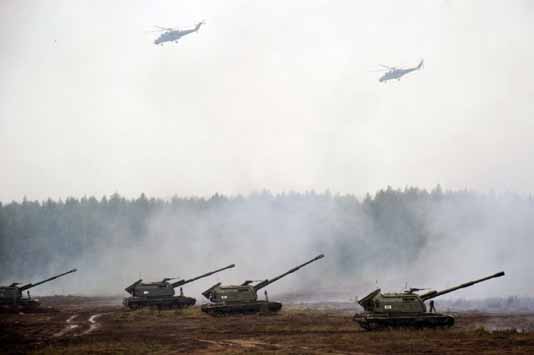CHITA, Russia, Sept 11, 2018 (BSS/AFP) – Russia launched Tuesday what
it called its largest ever military drills, with hundreds of thousands of
troops taking part along with Chinese soldiers in a show of force NATO
condemned as a rehearsal for “large-scale conflict.”
President Vladimir Putin is expected to attend the games after hosting an
economic forum in Russia’s far eastern city Vladivostok where his Chinese
counterpart Xi Jinping is one of the prominent guests.
The week-long war games dubbed “Vostok-2018″(East-2018) “have kicked off”
in far eastern Russia, the defence ministry said.
Taking part in the drills are around 300,000 soldiers, 36,000 military
vehicles, 80 ships and 1,000 aircraft, helicopters and drones.
Some 3,500 Chinese troops will take part in the games.
The defence ministry released video footage of military vehicles,
planes, helicopters and ships getting into position for the initial stage of
the drills.
Putin praised Russia’s increasingly close ties with China as he met with
Xi at the economic forum in Vladivostok on Tuesday.
“We have trustworthy ties in political, security and defence spheres,”
the Russian leader said.
Xi for his part said the two countries’ “friendship is getting stronger
all the time.”
The drills, which also include Mongolian soldiers, have been condemned by
NATO as a rehearsal for “large-scale conflict”.
The military exercises come at a time of escalating tensions between
Moscow and the West over accusations of Russian interference in western
affairs and conflicts in Ukraine and Syria.
The Russian army has compared the show of force to the USSR’s 1981 war
games that saw between 100,000 and 150,000 Warsaw Pact soldiers take part in
“Zapad-81” (West-81) — the largest military exercises of the Soviet era.
But Defence Minister Sergei Shoigu said these exercises are even larger.
“Imagine 36,000 military vehicles moving at the same time: tanks,
armoured personnel carriers, infantry fighting vehicles — and all of this,
of course, in conditions as close to a combat situation as possible,” Shoigu
said.
The exercises will be held across nine training ranges and three seas:
the Sea of Japan, the Bering Sea and the Sea of Okhotsk.
– ‘Routine work’ –
The Russian army is rolling out all of its latest additions for the
event: Iskander missiles that can carry nuclear warheads, T-80 and T-90 tanks
and its recent Su-34 and Su-35 fighter planes.
At sea, the Russian fleet is deploying several frigates equipped with
Kalibr missiles that have been used in Syria.
Wednesday will see games featuring anti-aircraft technology, while the
main event will be on Thursday, the defence ministry told journalists
covering the event in eastern Siberia and the Far East.
NATO said that Vostok-2018 “demonstrates Russia’s focus on exercising
large-scale conflict”.
“It fits into a pattern we have seen over some time — a more assertive
Russia, significantly increasing its defence budget and its military
presence,” the alliance’s spokesman Dylan White said late August.
Putin’s spokesman Dmitry Peskov dismissed such concerns on Tuesday.
“These are very important drills but they are part of routine annual work
to develop the armed forces,” he told journalists.
Peskov has earlier said Russia’s “ability to defend itself in the current
international situation which is often aggressive and unfriendly to our
country is justified, essential and without alternative”.
Relations between Russia and the West declined sharply in 2014 with
Moscow’s annexation of Crimea and the outbreak of a Kremlin-backed uprising
in eastern Ukraine.
The Kremlin has accused NATO of expanding westwards and threatening
Russian national security.
Moscow has increased the number of its large-scale military exercises in
the Caucasus, the Baltic and the Arctic in recent years.
Russia’s previous military exercise in the region, Vostok-2014, was
almost half the size, with 155,000 soldiers participating.
The country’s war games in Eastern Europe last year, Zapad-2017, saw
12,700 troops take part, according to Moscow. Ukraine and the Baltic states
said the true number was far bigger.



